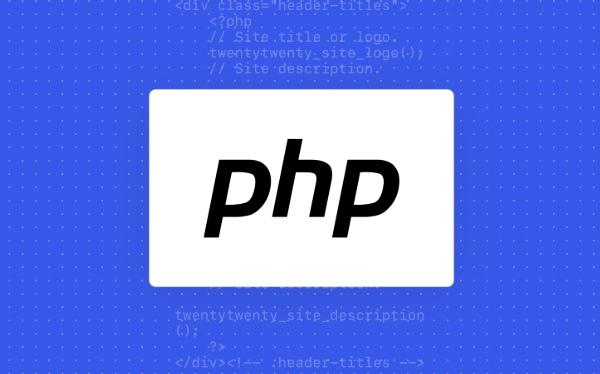 Backend Development
Backend Development
 PHP Tutorial
PHP Tutorial
 Metaprogramming in PHP: The Power of Attributes and Reflection
Metaprogramming in PHP: The Power of Attributes and Reflection
Metaprogramming in PHP: The Power of Attributes and Reflection
Jul 25, 2025 am 04:42 AMPHP 8 attributes combine reflection to implement powerful metaprogramming. 1. Attributes are metadata that can be read at runtime, such as #[Route] for tagging classes or methods; 2. The Reflection API parses and instantiates attributes through getAttributes() and newInstance(); 3. Practical applications include routing systems, verification serialization and ORM mapping; 4. Best practices include keeping attributes concise, using type attributes, cache reflected results and avoiding abuse; 5. The target and repetition can be defined through Attribute constants, and ultimately implement clear and type-safe self-description code.

PHP has evolved significantly over the years, and with the introduction of attributes in PHP 8 , metaprogramming has become more powerful and elegant. Combined with Reflection , attributes allow developers to write cleaner, more expressive code that can inspect and react to metadata at runtime—opening the door to frameworks, ORMs, routing systems, and validation libraries that feel almost magical.

Let's break down how attributes and reflection work together to enable powerful metaprogramming in modern PHP.
What Are Attributes?
In PHP 8 , attributes are a native language feature that lets you add metadata to classes, methods, properties, parameters, and constants. Think of them as structured annotations—like PHPDoc comments, but actually usable at runtime and type-safe.

#[Attribute]
class Route {
public function __construct(
public string $path,
public string $method = 'GET'
) {}
}
#[Route('/api/users', 'POST')]
class CreateUserAction {
public function handle(): array {
return ['message' => 'User created'];
}
} Here, #[Route(...)] is an attribute applied to the class. Unlike comments, this is real PHP code that can be inspected and processed.
How Reflection Makes It Work
To read attributes at runtime, you use PHP's Reflection API . This allows your code to examine classes, methods, etc., and extract the attributes you've defined.

$reflection = new ReflectionClass(CreateUserAction::class);
$routeAttribute = $reflection->getAttributes(Route::class)[0] ?? null;
if ($routeAttribute) {
$route = $routeAttribute->newInstance();
echo "Path: {$route->path}, Method: {$route->method}";
// Output: Path: /api/users, Method: POST
}The key methods:
-
getAttributes()– gets all or filtered attributes -
newInstance()– instantiates the attribute class with the values you passed
This combo (attributes reflection) is what powers tools like Symfony, Laravel, and custom frameworks under the hood.
Practical Use Cases
1. Routing System
You can build a simple router that scans for #[Route] attributes and maps URLs to handlers.
$routes = [];
foreach (get_declared_classes() as $class) {
$ref = new ReflectionClass($class);
foreach ($ref->getAttributes(Route::class) as $attr) {
$route = $attr->newInstance();
$routes[$route->path] = [
'class' => $class,
'method' => $route->method,
];
}
}Now your app knows which class handles which endpoint—without configuration files.
2. Validation and Serialization
Use attributes to define validation rules or serialization behavior:
#[Attribute]
class Validate {
public function __construct(public string $rule) {}
}
class User {
#[Validate('email')]
public string $email;
}
// At runtime, inspect properties and apply validation
$ref = new ReflectionProperty(User::class, 'email');
$validation = $ref->getAttributes(Validate::class)[0]->newInstance();
if ($validation->rule === 'email') {
// validate format
}3. ORM Mapping
Doctrine-style mapping is now possible natively:
#[Attribute]
class Column {
public function __construct(
public string $type,
public bool $nullable = false
) {}
}
class Product {
#[Column('string', nullable: false)]
public string $name;
}A persistence layer can use reflection to generate SQL or hydrate objects based on metadata.
Best Practices and Pitfalls
- Keep attributes simple – they should be data containers, not contain complex logic.
- Use typed properties in attribute classes for better IDE support and safety.
- Cache reflection results in production – reflection is powerful but slow if repeated.
- Avoid overuse – not every config needs an attribute. Use them where they improve clarity.
Also, remember:
- Attributes can target specific elements via
Attribute::TARGET_CLASS,TARGET_METHOD, etc. - You can allow multiple attributes on the same element with
Attribute::IS_REPEATABLE.
Example:
#[Attribute(Attribute::TARGET_METHOD | Attribute::IS_REPEATABLE)]
class Middleware {
public function __construct(public string $name) {}
}Final Thoughts
Metaprogramming in PHP used to rely on messy workarounds—like parsing docblocks or relying on naming conventions. With attributes and reflection , you now have a clean, type-safe way to attach metadata and build intelligent systems that inspect code structure.
Whether you're building a micro-framework, an API layer, or just want cleaner configuration, attributes reflection gives you the tools to write expressive, self-describing code.
It's not magic—it's just modern PHP.
The above is the detailed content of Metaprogramming in PHP: The Power of Attributes and Reflection. For more information, please follow other related articles on the PHP Chinese website!

Hot AI Tools

Undress AI Tool
Undress images for free

Undresser.AI Undress
AI-powered app for creating realistic nude photos

AI Clothes Remover
Online AI tool for removing clothes from photos.

Clothoff.io
AI clothes remover

Video Face Swap
Swap faces in any video effortlessly with our completely free AI face swap tool!

Hot Article

Hot Tools

Notepad++7.3.1
Easy-to-use and free code editor

SublimeText3 Chinese version
Chinese version, very easy to use

Zend Studio 13.0.1
Powerful PHP integrated development environment

Dreamweaver CS6
Visual web development tools

SublimeText3 Mac version
God-level code editing software (SublimeText3)
 PHP Variable Scope Explained
Jul 17, 2025 am 04:16 AM
PHP Variable Scope Explained
Jul 17, 2025 am 04:16 AM
Common problems and solutions for PHP variable scope include: 1. The global variable cannot be accessed within the function, and it needs to be passed in using the global keyword or parameter; 2. The static variable is declared with static, and it is only initialized once and the value is maintained between multiple calls; 3. Hyperglobal variables such as $_GET and $_POST can be used directly in any scope, but you need to pay attention to safe filtering; 4. Anonymous functions need to introduce parent scope variables through the use keyword, and when modifying external variables, you need to pass a reference. Mastering these rules can help avoid errors and improve code stability.
 How to handle File Uploads securely in PHP?
Jul 08, 2025 am 02:37 AM
How to handle File Uploads securely in PHP?
Jul 08, 2025 am 02:37 AM
To safely handle PHP file uploads, you need to verify the source and type, control the file name and path, set server restrictions, and process media files twice. 1. Verify the upload source to prevent CSRF through token and detect the real MIME type through finfo_file using whitelist control; 2. Rename the file to a random string and determine the extension to store it in a non-Web directory according to the detection type; 3. PHP configuration limits the upload size and temporary directory Nginx/Apache prohibits access to the upload directory; 4. The GD library resaves the pictures to clear potential malicious data.
 Commenting Out Code in PHP
Jul 18, 2025 am 04:57 AM
Commenting Out Code in PHP
Jul 18, 2025 am 04:57 AM
There are three common methods for PHP comment code: 1. Use // or # to block one line of code, and it is recommended to use //; 2. Use /.../ to wrap code blocks with multiple lines, which cannot be nested but can be crossed; 3. Combination skills comments such as using /if(){}/ to control logic blocks, or to improve efficiency with editor shortcut keys, you should pay attention to closing symbols and avoid nesting when using them.
 How Do Generators Work in PHP?
Jul 11, 2025 am 03:12 AM
How Do Generators Work in PHP?
Jul 11, 2025 am 03:12 AM
AgeneratorinPHPisamemory-efficientwaytoiterateoverlargedatasetsbyyieldingvaluesoneatatimeinsteadofreturningthemallatonce.1.Generatorsusetheyieldkeywordtoproducevaluesondemand,reducingmemoryusage.2.Theyareusefulforhandlingbigloops,readinglargefiles,or
 Tips for Writing PHP Comments
Jul 18, 2025 am 04:51 AM
Tips for Writing PHP Comments
Jul 18, 2025 am 04:51 AM
The key to writing PHP comments is to clarify the purpose and specifications. Comments should explain "why" rather than "what was done", avoiding redundancy or too simplicity. 1. Use a unified format, such as docblock (/*/) for class and method descriptions to improve readability and tool compatibility; 2. Emphasize the reasons behind the logic, such as why JS jumps need to be output manually; 3. Add an overview description before complex code, describe the process in steps, and help understand the overall idea; 4. Use TODO and FIXME rationally to mark to-do items and problems to facilitate subsequent tracking and collaboration. Good annotations can reduce communication costs and improve code maintenance efficiency.
 Quick PHP Installation Tutorial
Jul 18, 2025 am 04:52 AM
Quick PHP Installation Tutorial
Jul 18, 2025 am 04:52 AM
ToinstallPHPquickly,useXAMPPonWindowsorHomebrewonmacOS.1.OnWindows,downloadandinstallXAMPP,selectcomponents,startApache,andplacefilesinhtdocs.2.Alternatively,manuallyinstallPHPfromphp.netandsetupaserverlikeApache.3.OnmacOS,installHomebrew,thenrun'bre
 How to access a character in a string by index in PHP
Jul 12, 2025 am 03:15 AM
How to access a character in a string by index in PHP
Jul 12, 2025 am 03:15 AM
In PHP, you can use square brackets or curly braces to obtain string specific index characters, but square brackets are recommended; the index starts from 0, and the access outside the range returns a null value and cannot be assigned a value; mb_substr is required to handle multi-byte characters. For example: $str="hello";echo$str[0]; output h; and Chinese characters such as mb_substr($str,1,1) need to obtain the correct result; in actual applications, the length of the string should be checked before looping, dynamic strings need to be verified for validity, and multilingual projects recommend using multi-byte security functions uniformly.
 Learning PHP: A Beginner's Guide
Jul 18, 2025 am 04:54 AM
Learning PHP: A Beginner's Guide
Jul 18, 2025 am 04:54 AM
TolearnPHPeffectively,startbysettingupalocalserverenvironmentusingtoolslikeXAMPPandacodeeditorlikeVSCode.1)InstallXAMPPforApache,MySQL,andPHP.2)Useacodeeditorforsyntaxsupport.3)TestyoursetupwithasimplePHPfile.Next,learnPHPbasicsincludingvariables,ech





